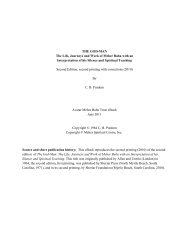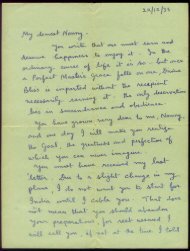In His Service - June 2011 - Avatar Meher Baba Trust
In His Service - June 2011 - Avatar Meher Baba Trust
In His Service - June 2011 - Avatar Meher Baba Trust
Create successful ePaper yourself
Turn your PDF publications into a flip-book with our unique Google optimized e-Paper software.
<strong>Baba</strong>’s Birthday<br />
Celebrations<br />
On a typical night at the <strong>Avatar</strong>’s Samadhi on <strong>Meher</strong>abad Hill, everything<br />
shuts down between eight p.m., when evening arti ends, and six<br />
a.m., when the day starts with tomb cleaning. Thrice in the annual<br />
calendar, however, this rule is lifted: on December 31, when pilgrims<br />
and residents welcome in the New Year with songs and<br />
celebration; over the three days of the Amartithi gathering; and on<br />
<strong>Baba</strong>’s Birthday.<br />
Early morning on 25th February is always a magical time. The crowd<br />
starts to gather in the chilly darkness from as early as three a.m., and<br />
soon, the space between the Samadhi and the Sabha Mandap swarms<br />
with people. Since the baby Merwan was born in Poona 117 years ago at<br />
five a.m., that moment climaxes the annual early-morning build-up, as a<br />
rousing “<strong>Meher</strong> Dhoon” (a singing of <strong>Meher</strong> <strong>Baba</strong>’s name) culminates in<br />
seven cries of “<strong>Avatar</strong> <strong>Meher</strong> <strong>Baba</strong> ki Jai!”<br />
After that, singing in the portico<br />
continues for several hours, as the light<br />
streaks and illuminates the sky. Tea and<br />
rava (an <strong>In</strong>dian sweet) are served as<br />
prasad. The Samadhi itself is heaped<br />
high with garlands, and the portico<br />
is strung with colored lights and<br />
flowers and ornaments. By<br />
Amartithi <strong>2011</strong><br />
The forty-second Amartithi, commemorated<br />
over the three days from 30th January through<br />
1st February, drew a record crowd this year,<br />
with 17,261 pilgrims registered for overnight<br />
accommodation, about a thousand more than<br />
2010. Despite the size, the event went smoothly,<br />
due in part to a large and seasoned volunteer<br />
staff and organizational systems and infrastructure<br />
that have been evolving for four decades.<br />
For many <strong>Baba</strong> lovers around the world<br />
and especially throughout <strong>In</strong>dia, Amartithi provides<br />
the main opportunity for darshan at <strong>Meher</strong> <strong>Baba</strong>’s Samadhi. About<br />
16,000 pilgrims took darshan this year on Amartithi day itself; astonishingly,<br />
all pilgrims with tokens were able to complete their darshan by<br />
11:30 at night, as has not been the case in recent years.<br />
As always, the<br />
main event at<br />
Amartithi is the<br />
fifteen minutes<br />
of silence starting<br />
at noon, as the<br />
assembled crowd<br />
commemorates that final quarterhour<br />
culminating in the <strong>Avatar</strong>’s<br />
dropping <strong>His</strong> body in 1969.<br />
As in the past the<br />
program on the stage in<br />
the amphitheater featured<br />
a variety of live performances—bhajans and other songs,<br />
dances, and other entertainment—as well as film.<br />
eight a.m. most of the<br />
pilgrims have taken their<br />
darshan, and the crowd<br />
disperses for breakfast.<br />
PHOTOGRAPHS BY FRANK BLOISE<br />
THIS YEAR’S BIRTHDAY PLAY, “The Secret <strong>His</strong>tory of the Taj Mahal,”<br />
dramatized a narrative that Eruch Jessawala had related to <strong>Baba</strong> during<br />
the New Life in Mahabaleshwar, probably in March of 1951. Emerging<br />
exhausted from <strong>His</strong> seclusion work, <strong>Baba</strong> wanted to be entertained. Eruch<br />
responded with a beautiful story, unknown to the historians and the<br />
chroniclers of the period, explaining how the inspiration for this great<br />
architectural masterpiece was achieved.<br />
childbirth, and the other involving the Persian architect Shirazi and the<br />
Rajput princess Rehana.<br />
These romantic plots were interwoven with the history of the Mughal<br />
wars of conquest against the Hindu kingdoms of Mewar and<br />
Ahmednagar. Two of Jahan’s sons, Dara and Aurengzeb, personified the<br />
conflict between religious puritanism and transcendent mysticism, themes<br />
which were brought into relation with the central romantic drama. By the<br />
The main action of the play was set at the height of the Mughal era<br />
in the seventeenth century during the reign of the Shah Jahan. It<br />
centered on two love stories and two heartbreaks, one involving<br />
the Shah Jahan and his beloved queen Mumtaz who died in<br />
end of the story Shirazi and Rehana,<br />
protagonists, transcend the “idolatry”<br />
and awaken to the love<br />
of God.<br />
the play’s two<br />
of human love



